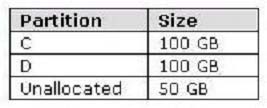

You have a computer that runs Windows 7. The computer contains one hard disk. The hard disk is configured as shown in the following table.
You install a new 250-GB hard disk in the computer.
You need to ensure that all the files on the computer are available if a single disk fails.
What should you do?
Comments